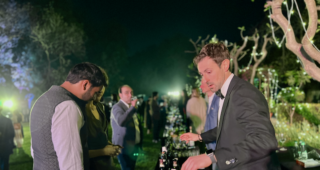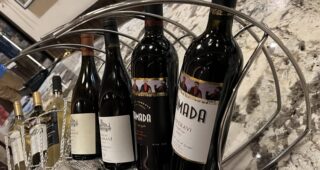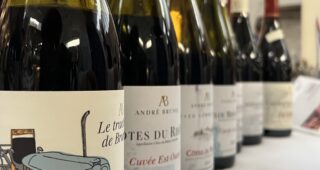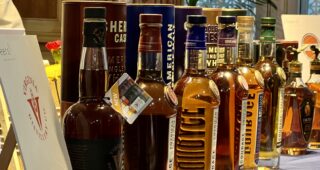Beauty lies in the eye of beholder and so every individual has personal preferences. Maybe this is the reason some people prefer a wine that is complex and long lived, while others go for an easy drinking version that could be consumed soon after bottling. This theory of preferences crossed my mind as I entered the beautiful maison of the Champagne house Michel Gonet that takes a lot of pride in its specialisation of Blancs de Blancs– and has a definite loyal clientele for that. Located astride the celebrated Avenue de Champagne in Epernay that is dotted on both sides with famous names from the world of Champagne, Michel Gonet undoubtedly has its position of pride in the milieu.

The Champagne house established in 1802 by Charles Gonet has 40 hectares of vineyards – majority of them being in the Grands Crus of Cotes des Blancs region known for its affinity to the Chardonnay grape varietal. The house also grows around 20% of their total production as Pinot Noir (red grape varietal) that is used for tinting their Rosé Champagne and also to produce a vintage cuvée. Apart from Champagne, the Gonet family owns nine wine estates in Bordeaux that produces different styles of Red and White still wines in varying styles and are managed by the other siblings of the current Gonet generation.

Coming to our visit, it was a pleasing sight as we entered the typical French villa beset with large and ethereal glass windows and wooden flooring, shod with luxurious carpets at the right places. There were colourful Champagne bottles adorning the visitors’ lounge that we clicked for posterity while waiting for Madame Sophie Signolle, daughter of Michel Gonet and the Charge d’Affaires at the Champagne house. Soon enough, we were escorted to the adjoining dégustation room where the first wine for tasting was already resting in the chilling bucket.
The tasting proceeded as under:

Michel Gonet Millésimé 1998 Grand Cru Brut
Grapes: 100% Chardonnay
Alcohol : 12%
This wine won the Medaille d’Or (Gold Medal) in Concours d’Epernay 2003- an annual competition of Champagne wines. It was great to start our tasting with this wine as it was a delicately flavoured luxurious wine with a fruity nose and a creamy palate. The lingering finish lent it an extra edge and versatility to be used as an aperitif as well as a gourmet wine.

Michel Gonet Grand Cru Brut
Grapes: 100% Chardonnay
Alcohol : 12.5%
This pale gold wine with green tints conveyed its youthful nature from the outset. It was confirmed on the nose and palate as well, with its mineral and floral aromas and fresh fruity flavours. An excellent accompaniment with sea food!
Michel Gonet Brut Reserve
Grapes: 50% each Chardonnay and Pinot Noir
Alcohol : 12%
The only wine from MG stable other than Rosé to contain a Pinot Noir blend. It was but natural for me to like this one because of my strong inclination towards Blanc de Noirs and its blends. The wine poured with a restrained but powerful mousse and a discreet ring that was a treat to watch. It had a complex nose of citrus fruits, red berries and toasted bread. The palate was tremendously fruity with excellent structure and a smooth lingering finish. A powerful Champagne that can very well stand up to robust food like roasted lamb while at the same time gentle enough to handle sea food.

Cuvée Prestige 2001
Michel Gonet Cuvée Prestige 2001 Brut
Grapes: 100% Chardonnay
Alcohol : 12%
Greenish gold in colour with an abundant mousse and fine persistent bubbles. The pedigree of being a prestige cuvée showed with a powerful, fruity and honeyed nose. On the palate it was refreshing with flavours of plums, honey and nuts. A delectable wine you can sip as an aperitif to light up the occasion!
Michel Gonet Cuvée Prestige 2004 Extra Brut
Grapes: 100% Chardonnay
Alcohol : 12%

Extra Brut is drier than Brut- in that the residual sugar content in the wine is much lesser.This wine received the Silver Medal at the Chardonnay du Monde 2010 competition- an annual fixture to judge best Chardonnay based wines.
The wine was medium gold in colour with a very expressive nose of ripe pears, dried fruits and bread crust. On the palate it was mouth filling and creamy with good acidity to balance the fruit. A decent long finish makes it a good gourmet wine.

Thus concluded the wonderful tasting session led by the passionate winemaker in Mme Sophie Signolle who highlighted the Champagne house’s emphasis on the traditional way of wine making yet adapting to modern technology, to produce high quality artisanal wines. They have also embraced a pesticide free organic ecosystem to retain the naturally fresh character of their wines.
Sure enough, we found the wines to be fresh, minerally, pleasingly complex and some of the best Blancs de Blancs we tasted during our Champagne stay.
We could however not get to taste their oaked Blanc de Blancs with a traditional shellac sealed bottle closure due to only one bottle being available at that point of time, and Sophie needing to preserve it for further showcasing during the day. I however took photos of the bottle since it was interesting to note how Dom Pérignon– the inventor of Champagne would have sealed the ‘stars’ he tasted in the wine way back in the 17th century.

And the sparkle has stayed on since then!









